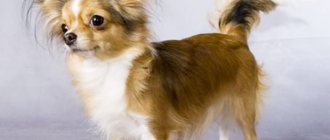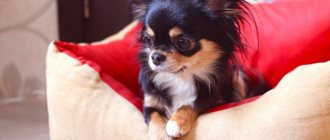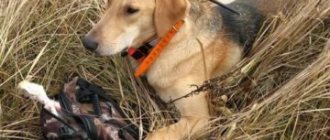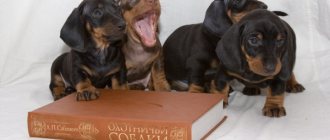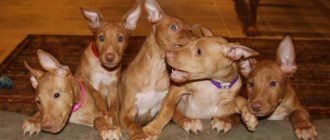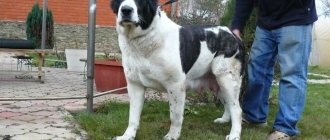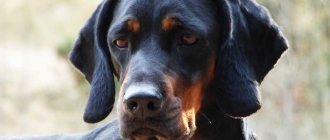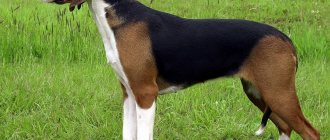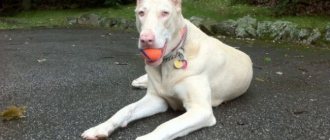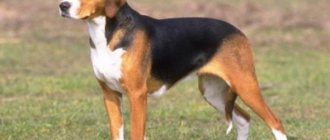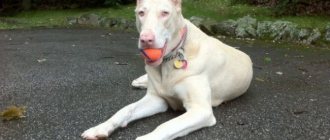White wool and a chiseled silhouette are the distinctive features of this breed of hounds, thanks to which it received the name Porcelain. Sometimes it is called porcelain, which in French means “porcelain”, sometimes a noble royal hound.
The graceful animal, indeed, resembles a figurine made of fragile material, and not just a simple one, but a precious one, considering the fact that there are very few representatives of this breed in the world, even in its homeland, France, and neighboring Italy and Switzerland . In other countries of the world, porselen, if present at all, is in tiny quantities.
Character and training
The Noble Porcelain Hound is a dog with a balanced, but very self-sufficient disposition.
You need to understand that Porselen on the hunt and at home are two different animals. In the field, the dog is pliable, very sociable, inclined to work in a group and for results. At home, Porselin is dignified and stubborn, but very loyal. When angry, this dog is merciless, and it only falls into a state of aggression when hunting or when protecting its family. Despite the languid look and calm behavior, Porselen is a very active dog, requiring daily and very serious exercise. Representatives of the breed cannot stand monotony; they need tasks not only for the body, but also for the mind. In training, Porselen is willful, he can follow a command only to get left behind, but will not obey outside of training.
Porcelain Hounds become very attached to their owners and do not tolerate separation well. Buying a puppy of this breed is a huge responsibility for the next 13–15 years. It is not advisable to leave Porselen with strangers during vacations or business trips, so assess your strengths and capabilities sensibly.
The character of this four-legged animal is too much for a beginner. In training, raising and socializing the dog, the owner must show toughness and persistence, but without the slightest hint of infringement or humiliation. Porselen is a royal dog, capable of remembering an unkind attitude and... able to repay in kind.
Historical reference
The Porselin dog breed is recognized as the oldest in France . Representatives of the breed have retained their incredible appearance since their inception. By the way, noble and royal are just regalia, and a porcelain hound is a description of appearance. The coat of these dogs lies very smooth, “soft” and shines like porcelain. In the royal courts these dogs were admired as if they were works of art.
The history of the breed is littered with gaps. According to one version, the Noble Porcelain Hounds originated from crossing hunting dogs from the territories of Ancient Greece, medieval Switzerland and England. It is known that during the development of fashion for hounds in England, Porcelains were crossed with the best representatives of hunting breeds.
The first mention of Porselen as an independent and separate breed dates back to the 15th century . The breed was developed in France; for the first time, breeding work was carried out in closed areas of monasteries. At that time, Bloodhounds (St. Hubert's Dogs) had already gained their popularity, and Porcelen was “thought” as a variety of this breed, but with a porcelain-white color.
Circumstances turned out differently, and Porselen was bred into a separate breed. In addition, strict rules stood in the way of innovative breeders, since light-colored Bloodhound puppies were considered defective. During the breeding of the Porselins, low-quality litters were destroyed, so enthusiasts were faced with a very difficult task. U, with which you could start working.
Starting from scratch, breeders managed to produce light-colored dogs similar to Bloodhound. The problem was that the first Porselins were beautiful, but weak in work. At a time when dogs were valued for their ability to help in the hunt, the role of a parasite did not bode well. Representatives of the breed were lucky because their incredible appearance was noticed by the highest strata of society. Breeding activities were taken under guardianship, and at the same time the issue of feeding and maintaining dogs lost its urgency.
Having secured the exterior in the gene pool, breeders began work to improve the working skills of the breed representatives. Only in the 18th–19th centuries did they start talking about the Porselen as a working and quite capable breed. The porcelain hound dog shone during the royal hunt, chasing down a hare and even a roe deer. The joy of the upper strata of society knew no bounds, because, in addition to the status of a good hunter, the presence of Porselen in the pack spoke of the wealth of the owner.
Description of the Austrian Hound
The standard positions the Austrian Black and Tan Hound exclusively as a universal, versatile hunting dog, suitable for both difficult and difficult work in mountainous terrain, and for driving animals in flat areas using the voice, as well as for searching for wounded animals by blood trail.
Appearance
The Austrian Bracket is a medium-sized dog, athletic and strong (but by no means heavy, thick or stocky) with light, fine bones and powerful muscles. A flexible, strong, lean body with a long back, clearly defined withers, a wide, voluminous sternum, a slightly arched loin and a moderately tucked belly line.
The body of the Austrian Hound is muscular and strong, but rather graceful and fine-boned.
Breed standard:
- Height at withers: females - 48–54 cm;
- males - 50–56 cm.
The Austrian Hound moves easily and lithely
The coat is short (up to 2 cm), strong and thick, tightly fitting the body, with a beautiful glossy sheen. The standard allows only one color - black with clearly defined, small tan marks, the color of which varies from light fawn to dark reddish brown. There must be two clear light spots above the eyes, forming a spectacular “four eyes”.
Disadvantages and disqualifying vices
The following are recognized as defects or deficiencies:
- some timidity;
- narrowed skull;
- elongated muzzle;
- pointed, shortened, too narrow or curled ears;
- a very thick or short tail, curled or carried high, and no rough hair underneath;
- weak limbs.
The reasons for disqualification will be:
- cowardice or aggressiveness;
- absence of clearly visible clear spots above the eyes;
- problems with the jaws (lack of teeth, overshot, undershot);
- any coloring that does not meet standard requirements;
- obvious behavioral, mental or physical abnormalities;
- cryptorchidism.
Character and psyche of the breed
The Brundle Bracket, like the vast majority of hounds, has a cheerful and cheerful temperament, while at the same time it has a firm, strong and stubborn character, allowing it to persistently and purposefully pursue prey. In everyday life, these dogs are obedient, calm and very balanced. They are strongly attached to their family, they need human society, and loneliness is unbearable. The agile and active Austrian hounds find it difficult to sit in one place for a long time without moving; running, jumping, playing and rushing around headlong is normal and natural for them.
The Austrian Hound needs to exercise a lot.
These hunting dogs play with children with pleasure, especially preferring outdoor games. They can show aggression towards other pets, but with proper and early socialization this can be avoided. All kinds of small animals will always be considered from the point of view of the hunter, so it is better not to keep rabbits, guinea pigs, birds and other animals together with hounds. Brack can still put up with a domestic cat, but stray and neighbor cats are always a welcome prey for him.
Molossians
The Molosser section includes large dogs of a massive build with developed muscles and powerful jaws. It includes ancient herding and mastiff dogs. The former initially performed the duties of guards, defenders, and cattle drivers. The latter took part in bloody spectacles - baiting wild animals. In France, 2 Molosser breeds were developed.
Pyrenean mountain dog
Another name for the Pyrenean mountain range is the Great Pyrenees.
Powerful, but elegant, harmoniously built dogs. The height at the withers is from 65 cm in females to 80 cm in males. The color is solid white or with pale red-gray and yellow markings.
Pyrenean Mountain Dogs worked in tandem with Pyrenean Shepherd Dogs, serving as protectors of the herd from predators. Now the Great Pyrenees have become family pets - good-natured, patient and intelligent.
Dogue de Bordeaux
The Dogue de Bordeaux is an ancient fighting dog from southwestern France.
This is a large smooth-haired dog with a height of 58 - 68 cm. Average weight is 60 - 65 kg. The coat is thin, smooth, without undercoat. The only color is red-brown.
The stern appearance of the Great Dane is deceptive. For family members, this is a loyal, calm, good-natured friend and companion. According to the standard, Dogues de Bordeaux are adapted for protection, which they carry vigilantly, bravely, but without aggression. Good companions, attached to the owner. Affectionate, calm, balanced, with a high threshold of irritability. Males often have a dominant character.
How to choose a nickname?
Representatives of hound dog breeds are characterized by tirelessness, swiftness, vocality, loyalty, sensitivity and responsibility. The animal's nickname should be unusual, sonorous, and most importantly, the dog should respond to it. When choosing a name, you should take into account the characteristic features of the dog, for example, Thunder can be called a hound with a loud voice, but Wind is one that is difficult to keep up with.
It is strictly not recommended to give the names of dead animals, as this may affect the fate of the dog. If the hound already had a name, then you should not give it a new name. If a dog responds to its name, then it should be rewarded. A representative of this breed can be called Agat, Aira, Astik, Bayra, Burya, Vast, Glan, Gella, Drag, Dune.
Temperament
The Porselen hound is distinguished by its impulsive character and speed. She has a clear voice and excellent instincts, designed for hunting small game, more often hares.
At home, Porcelain dogs are calm and obedient. They are not ready to be alone and love company. Porcelains become attached to all family members, forgive children for intrusiveness, and always support noisy games.
This is not a very suitable breed for beginners. It is more for those who have already had experience in keeping dogs.
The Porcelain Dog can be independent and stubborn, so it is recommended to be persistent when training and training it.
The energetic and active temperament of the Porcelain Dog makes it an excellent companion for an owner who is willing to devote a lot of time to walks and games in the fresh air.
Description of the breed
Dog handlers say: this breed is not suitable for an inexperienced dog breeder - you need to know its characteristics well, show patience and sometimes firmness in matters of care and education.
Breed standard
Here's how experts characterize the breed:
- the head is elongated, as if sculpted by a sculptor (how could it be otherwise for a porcelain dog?);
- large brown eyes are reliably protected by eyelids, the look is intelligent;
- ears - large, soft, curled inward, located on the line of the eyes, and sometimes slightly lower;
- the nose and mucous membranes of the lips are black;
- neck – long;
- body – stretched, back – wide;
- chest - quite wide, well developed, low dropped;
- the tail, strong at the base, gradually turns into a thin, slightly curled tail;
- the limbs are straight and long, but could have been more graceful for such an exquisite breed;
- The pads on the paws are hard.
The coat of a porcelain dog is its undoubted pride: smooth, with a vibrant shine, without any bald spots. The color is also worthy of admiration; experts characterize it as “bright white.” It is interestingly complemented by orange spots, mainly on the ears. Typically, staining occurs where the skin contains black pigment.
Interestingly, a white fur coat will not require frequent water treatments for your pet. The structure of the wool is designed in such a way that it repels dirt well. But in order for the pet to always look perfect, the owner needs to arm himself with a brush several times a week that will comb out dead hairs from the fur coat. This procedure will only take a few minutes.
The size of the animal is acceptable for home keeping. Males are larger than young ladies, their height is from 55 to 58 centimeters (their girlfriends are from 53 to 56). Animals weigh on average from 25 to 28 kilograms.
The lifespan of these exquisite animals is between 13 and 15 years.
Appearance
Perselen is an elegant, proportionally built medium-sized dog with a beautifully chiselled head, long ears and slender, strong legs. The main distinguishing feature is the short white-red fur, through which dark spots on the skin are visible. Sexual dimorphism is moderately expressed.
- Height at withers: 54-58 cm
- Weight: 25-28 kg cm
The head is dry, chiseled. The skull is wide between the ears, rounded. Stop moderate. The muzzle is long, the bridge of the nose is straight or with a slight hump. The lobe is developed, black. The upper lip slightly covers the lower one, without sagging. Mucous black. The eyes are dark and medium in size. The ears are long, thin, curled inward, set below the eye line. The neck is long, a slight dewlap is allowed.
The body is proportionally folded, square format. The back is wide and straight. The loin is convex. The maklaks are slightly noticeable. The chest is moderately wide and deep. The belly is tucked in. The tail is thick at the base, tapers noticeably towards the tip, and is of medium length. The limbs are strong, rather long, dry.
The skin is elastic, thin, and is called “marbled” because of the numerous black spots on a white background. The coat is thin, smooth and shiny, and lies tightly. The color is white with orange spots that do not blend into the coat.
Hunting
The French Braque is a faithful companion and an excellent hunter. Quadrupeds have developed sense of smell and hearing, instinctively make a firm stance, capable of working hard, but achieving their goals. Representatives of the breed have an innate instinct to fetch, interestingly, but even French Braque puppies are not afraid of shots.
In work they are used as tracking, gun and pointing dogs. Thanks to its short but very dense coat, the French Braque can work for a long time, despite the weather conditions. According to the experience of hunters, dogs show excellent results when working on water, swampy and bushy areas, on plains and even in sand.
Classification
They differ in the methods of hunting the animal:
- Weld hunting, when the dog works in a group.
- Working on a blood trail. Allows you to pursue an animal wounded by a hunter and catch game.
- Trace rocks. Due to a particularly developed sense of smell, they track prey, find holes, and drive them in.
- For hunting on foot. They recognize traces and notify about their location.
- Complex baiting, catching an animal. Horses are used for riding hunters, the pack accompanies, finds the wounded animal or reports the victim with a sonorous bark.
A special group is gun dogs. They are not afraid of loud sounds or gunshots. Their task is to find prey and hunt down the beast.
Choosing a puppy and the cost of a Pharaoh Hound
Pharaoh hound puppies are quite expensive, while the prices of many breeders are almost identical, but the quality of the litters varies greatly. Therefore, choosing a cattery and parents should be a top priority for a potential owner.
Recently, in cynology, it has been customary to divide puppies into classes: show, breed and pet. Whatever class the dog belongs to, it must have a pedigree. Breeding and show-class dogs with good external characteristics and prospects for a show or breeding career. Pet class - for home and family. Usually this is a larger number of puppies per litter with an average cost. Not always, but sometimes they may have some exterior defects that do not affect health, but do not allow them to participate in exhibitions and breeding.
Having chosen a nursery and a breeder, having waited for the litter, you can go to the long-awaited show
The first thing you need to pay attention to is the living conditions of the puppies and their parents. After this, you need to make sure that the documents are available and only after that proceed to the examination and selection of the baby
Where to buy a Polish Hound puppy
Today, more than 6,000 dogs are registered in the Polish pedigree database. The majority of nurseries are located in Poland. Over the past 5-10 years, dogs have increasingly been imported to other countries. Polish hounds are popular with hunters in France, the Czech Republic, Germany, Hungary, Lithuania, Georgia, Italy, Norway, Portugal and even in Africa. They were also imported to Ukraine and Russia, where in 2015 the first litter was received from 2 imported dogs.
It is better to look for a dog through the Polish Club of Polish Hound Lovers. Here they will give comprehensive information about puppies, planned litters, representatives of the breed in the country and abroad. Many advertisements can be found on the Polish site OLX, but they are very rarely found on similar sites in other countries.
Description of the Finnish hound breed
Thoroughbred representatives look like other hounds. They have a body type characteristic of a working dog, having medium dimensions, strong, well-developed muscles and a fit, compact body. The dog's hind legs are slightly sloping, which visually makes them stronger and more stable.
Dogs of this breed, based on their specificity, must chase the animal for a long time and at the same time bark loudly and loudly. Therefore, they are equipped with a wide chest that can accommodate fairly large lungs.
Males and females differ in size, but their temperament is very similar. Females show no less anger towards the beast, and some experienced hunters claim that in this characteristic they are significantly superior to males.
The height of males varies from 45 to 52 cm, females - from 42 to 49 cm, Finnish hounds weigh from 20 to 25 kg, body weight does not depend on the sex of the animal. Bitches have a more elongated body, which is due to their reproductive function.
In the standard you can find the following descriptions of representatives of the breed:
- The head is small, rectangular in shape, not weighted, with a rounded forehead and a smooth transition to the muzzle, the lines of the head are clearly defined. The bridge of the nose is straight.
- The jaw is strong, with not raw, pigmented lips and large, tightly set teeth. They create a complete row, the bite is correct - scissor.
- The nose is large, wide, very sensitive and mobile. In most individuals it is black; in dogs with light fur it can be brown.
- The eyes are almond-shaped, medium in size, slightly slanted, with an expressive, interested look. The eyelids are black or dark brown and fit tightly. The iris should be as dark as possible.
- The ears have rounded tips, hang down at the sides, are not very fleshy, mobile at the base, have no folds and are not covered with long guard hairs.
- Finnish dogs and dogs have a strong, harmonious physique; the dogs are not heavy, lean, they have lean, well-developed muscles. The skin fits tightly, does not form folds or sagging.
- The withers are well defined and muscular, the chest has an impressive volume and decent width. The rib bones are round in shape, making the sternum barrel-shaped.
- The short back extends into a well-defined lumbar region and a muscular, medium-length, sloping croup.
- Limbs. Strong, thick, oval-shaped bones, with flexible, powerful articular joints. The Finnish hound cannot be called short-legged - its limbs are proportional to the body. The brushes are medium in size, oval in shape, collected in a dense ball, with strong, strong claws.
- The tail is a continuation of the line of the back, thick at the base, but gradually becomes narrower towards the end. Slightly curved, the dog carries it freely or slightly elevated, but not higher than the spinal column.
Color and texture of Finnish hound fur
Finnish hounds have dense, short hair, its texture resembles the coat of other varieties of similar breeds. It is tough with a thick, abundant undercoat, so the dog is protected from low temperatures and water - it is difficult for it to penetrate the skin through such a layer.
There is also a grease lubricant that has water-repellent properties. The latter makes it possible to use representatives of this breed for hunting waterfowl.
At first, no special attention was paid to the color of the coat of these dogs and there were no requirements. But when the standard was being formed, it included only individuals with a tricolor color.
Black, white and red fur are allowed. Most often, dogs have a black back, and in the area of the head, tail and limbs, red and black hair are combined in different proportions.
Finnish hounds have a white muzzle and also have a white stripe on the head. The standard allows for white fur on the chest, legs, belly and tail. Some dogs do not have white spots in these areas, but this is not a disadvantage.
Medium breeds of hounds
The group is compact in size with an energetic and fearless character. Many of them are suitable for city apartments, with a mandatory vigorous walking. They are quite peaceful, for the most part they can live in families with animals and children.
Norwegian Hound (Dunker)
It took shape at the beginning of the 19th century in Norway. The goal is to track the hare. Capable of finding prey, chasing it away and bringing it to its owner. Can work in hot and cold weather, in the snow. It is distinguished by persistent pursuit at not very high speeds.
Height – 47-55 cm at the withers, weight – 16-25 kg. The body is slightly elongated, the legs are high and muscular. The Dunker's ears are long, soft, rounded, and hang down. The coat is short, marbled blue and tan or tri-colored.
- This is a balanced and patient dog, rarely gets into fights, and is easy to train. However, she is somewhat independent in making decisions.
- Keeping it in a country house is recommended, with mandatory physical activity.
Porcelain hound (porselen or noble royal)
A rare breed, bred in France in the 15th century. It was almost destroyed during the French Revolution, but was later restored. It got its name due to its color and graceful appearance. It often walks in a pack and is used to herd hare, roe deer, and sometimes wild boar. May follow the trail of a wounded animal.
The height of the dogs is 53-58 cm at the withers, weight is 26-30 kg. Porselen has a proportional build, is elegant, and long-legged. The skull is broad, slightly elongated, and the ears have a pointed edge. The tail is thick, whip-like. The color is white, with red spots or specks.
At home he is a calm, kind, friendly dog, but on the hunt he is the embodiment of excitement and impulsiveness. Not for apartment conditions.
Harrier
Harriers are the basis of many breeds; England is considered its homeland. Selection was carried out to obtain dogs for riding hares, foxes, and sometimes wild boars. It is distinguished by its high-speed running, including over rough and mountainous terrain, its temperament and willfulness.
Height – 46-53 cm, body weight – 20-27 kg. The body is strong and stocky, the muzzle is elongated, pointed, with a flat skull. The ears are short in length and resemble the letter V. The tail is thick and raised up. The length of the coat is medium, it is not soft. Three-colored colors are more common, but all those characteristic of the species are acceptable. Requires persistent and long-term training.
Suitable as a family dog with the obligatory energetic walking, trips to nature, as well as jogging behind a bicycle or horse.
Estonian hound
A young breed, formed in the mid-20th century, when in Estonia there was a ban on hunting with dogs over 45 cm. Not officially registered by the FCI. Used for tracking hares, rabbits, foxes, and other small animals. Persistent, can keep a trace for up to 3 days.
The height of the animal is 42-52 cm, weight is 10-25 kg. Visually, Estonians resemble beagles. The body is stretched, the head is rounded, with an elongated muzzle. The ears are quite long, their tips are rounded. The height of the coat is small and hard. Black and piebald, less often brown or crimson piebald.
Dogs are affectionate, balanced, love children, and tolerant of other pets. Apartment housing is possible if there is high physical activity, but living in a house with a spacious enclosure is better suited.
Swiss Laufhund
One of the oldest breeds. Similar dogs existed in Ancient Egypt, then with Roman legionnaires they found their way to the Alps. They are the progenitor of many hounds. Bred for hunting hare and fox. Can also be used for baiting wild boar. They work well on the blood trail. Nowadays they are more often used in solo hunting on foot.
There are short-legged and long-legged varieties. The height at the withers of the former is 32-41 cm, weight – 14-18 kg, the latter – 46-59 cm and 16-23 kg.
- The Laufhund's body is elongated, its head is stretched, graceful, with a double chin. The ears are long and cone-shaped. The coat is short, harsh or smooth. The color is white, with large red or yellow spots.
- Laufhunds are distinguished by their absolute fearlessness, loyalty, and very high intelligence. They are wary of strangers and do not get along well with other animals. Not suitable for living in apartment conditions.
Content Features
Porselen is better suited for home keeping. It is poorly adapted for year-round life on the street, but can live in a separate warm room with access to a spacious enclosure. Not the best option for an apartment if the owner cannot provide a sufficient level of physical activity.
The Porcelain Hound needs the opportunity to get rid of excess energy, develop hunting talents and maintain good physical condition. Daily walking should last at least 2-3 hours. Free walks in nature are required. Perselen can be a running or cycling companion.
Care comes down to simple hygiene procedures: regular brushing for short-haired breeds, washing, periodic cleaning of ears, teeth and trimming of nails as necessary.
About the breed Porselen (Porcelain Hound)
Character
Porselen has a calm character. This is a hardy, fast and passionate dog. Being in a pack, he gets along well with his relatives. On the hunt she is tireless and merciless, very vicious towards the beast. Each family member becomes a devoted and affectionate friend. Affectionate. Energy and mobility will make this dog a good companion for an active person who can devote a lot of time to walks, games and competitions in the fresh air, sports and, of course, hunting. Porcelain Hounds require competent training, they need a patient owner with experience in raising dogs and a strong character. This breed is not suitable for beginners in dog breeding. The character of this dog shows firmness and some independence; when training and raising the animal, the owner must be persistent.
Appearance
The Porcelain Hound creates the impression of an unusually beautiful, graceful and sophisticated dog with a proportional physique. The head seems to be sculpted, graceful, medium in size, not heavy. The height at the withers varies between 56-59 cm, and weight - 25-28 kg. The ears are quite large and drooping. The chest is wide, of medium depth, well developed. The solid white coat is composed of fine, short hairs that lie close to the skin. There may be small orange spots on the body, which darken and become especially noticeable on the animal’s ears.
Hunting with Porselen
Mostly, the porcelain hound is used to hunt small animals such as hare, as well as various deer and roe deer. But these dogs can also be used when hunting wild boar. Persistence and impulsiveness allow this dog to hunt in any weather conditions on any terrain. Possessing a keen sense of smell and a loud, booming voice, she is persistent in her search and performs well both when working in a pack and alone.
Maintenance and care
The breed is absolutely unpretentious in maintenance. Can live both within the city and outside it. However, porselen needs regular physical activity, which is easier to provide in nature, where the dog will have more space.
It is very important for the dog to be given the opportunity to get rid of excess energy, since active physical activity is the main factor in maintaining good physical and working shape, and most importantly, a healthy lifestyle. Care is very simple - regular cleaning of the coat with a special brush. Frequent washing is not necessary; it is better to do this only in cases of heavy soiling.
The lifespan of a porcelain hound is about 13-15 years.
based on materials from the free encyclopedia “Wikipedia”
Health
The average lifespan of a Porcelen ranges from 13–15 years. Purebred dogs are few in number and their genetic defects cannot be studied statistically. In general terms, the Porselen is considered a healthy breed, not prone to serious illnesses (subject to decent care, maintenance and feeding).
Due to their build, representatives of the breed are prone to injuries to the musculoskeletal system. Joint dislocations and sprains are common, so Porselen needs regular, strengthening training. Dysplasia also occurs in representatives of the breed, but so far it is considered an acquired and not a hereditary disease.
Again, due to their physique, Porselens are prone to the rapid development of ear infections, in other words, otitis media of varying nature and intensity. You need to pay special attention to caring for your dog's ears, as mild inflammation progresses very quickly. In old age, if a dog has suffered from otitis media or suffers from this disease in a chronic form, there is a high probability of developing hearing problems.
Important! Porselens are sensitive to narcotic (anesthesia) and other strong medications. Some owners noted that their pets had difficulty withstanding vaccination, despite proper preparation.
American Foxhound: character
What can you say about the character of the American Foxhound? These are very active dogs that love to run, bark and generally play pranks. Therefore, if you have teenage children at home, then they will find a common language with this dog very quickly and it is still unknown who will drive who faster. We do not recommend leaving this dog with small children; after all, this is not a nanny, but a hunter. Therefore, if a child allows himself something extra, he can easily get what he deserves from the dog. How are things going with the animals?
If you already have an American Foxhound at home, and you decide to get yourself another dog or cat, then you may have problems. The dog may become jealous of the new tenant, both you and the tenant will have problems, therefore, if you decide to get another pet, you will have to make sure that the first owner of the house treats him normally. The dog is suspicious of strangers, and at the slightest sign of danger, the Foxhound can become aggressive, deciding that the owner needs to be protected.
As you understand, a dog that can deal with a wild boar or a puma can deal with your offender in a matter of minutes. Therefore, be careful, the dog needs to be accustomed to the company of strangers, from a very young age you need to take the dog outside and show it that besides it and you, there are other people and animals in the world. It is clear that in order for you not to have problems, the dog also needs to be trained.
American Foxhound: training
American Foxhounds are very smart dogs, so you won't have any problems with training. A general course of training can be easily given to the dog at home on your own; in just a couple of weeks the dog will know and flawlessly carry out all the basic commands, but this is subject to constant training. If you are careless about dog training, nothing good will come of it. The dog will confuse commands and will obey you every now and then. After the general course of commands has been mastered, you can go to a special school or courses, where an experienced instructor will help your dog master some specific training course, this may not only be baiting the animal. These dogs can easily cope with security work or become your bodyguard. If you don’t know how to train a dog at home, then it’s better not to start, contact a dog trainer right away or read specialized literature, there’s a lot of it now.
Upbringing
Do not confuse this concept with training; by training, you teach the dog to carry out some commands. And by raising her, you teach her good manners. Agree, it is unpleasant and even embarrassing when your dog behaves unworthily, barks or lunges at passers-by, jumps on guests, and so on. These are all signs of poor dog training. If experts do not recommend starting training before the dog reaches three months of age, then training should begin as soon as the American Foxhound puppy gets into the house. Teach your puppy to respond to his name, ask to go outside to use the toilet, and teach him not to jump on you or guests who come to you. Don't let him bark loudly for any reason, and most importantly, don't let him sleep on the bed. The dog will get used to the fact that the sofa is a bed, and then it will perceive all sofas that way. Imagine you came to visit with your pet, and he jumped on your friends’ sofa next to you.
Where can I buy
It is quite difficult to buy an American Foxhound from us, although if you wish, you can find private breeders of these dogs or even kennels. The price of an American Foxhound may unpleasantly surprise you; such dogs cost from 800 to 1300 US dollars, and you are unlikely to find them cheaper. And the price is due precisely to the fact that the American Foxhound breed is very rare in our area, say, in the states you can buy such a puppy much cheaper, but whether you can take it out from there is another question. The fact is that dogs of this breed are considered a national treasure and it is not a fact that you will be allowed to transport a puppy of such a dog across the border.
Care
It is not difficult to care for this breed of dog; they are unpretentious in maintenance and nutrition. We can say that this dog can eat anything. Their fur is short, so in order for the dog to look neat, it is enough to wipe it daily with a special mitten. This will keep the coat looking clean and well-groomed. You need to keep your ears clean, make sure there is no inflammation in your eyes, and so on, everything is pretty standard. American Foxhounds are distinguished by excellent health and with proper maintenance they can live up to 15 years, giving you joy and good mood.
Care
No special care is required for the Porcelain Hound.
Health
Dogs that are fairly healthy may have some hereditary diseases:
- joint dysplasia as a result of increased activity of a sculpted animal, dislocations;
- puppies are often diagnosed with cryptorchidism, in which male dogs have to be removed from breeding without surgical intervention,
- hearing loss caused by chronic infections.
Some dogs do not tolerate anesthesia well.
Conditions of detention
The Porcelain Hound can live equally comfortably both in urban environments and outside them, if you provide it with constant long walks. Only when excess energy is released will the dog feel like a full-fledged hunter, and this is its main purpose.
Caring for the coat comes down to weekly cleaning with a brush. Frequent water treatments are not recommended; washing is only permissible if it is heavily soiled.
Due to the fact that the Porcelain Hound hunter often visits forested areas, due attention should be paid to the post-walk inspection of the animal for ticks. Inflammation-prone ears are another factor that requires close monitoring. Some warning signs that should prompt you to see a veterinarian include dog odor and restlessness.
Some warning signs that should prompt you to see a veterinarian include dog odor and restlessness.
Inflammation-prone ears are another factor that requires close monitoring. Warning symptoms that should prompt you to contact a veterinarian include odor and restlessness in your dog.
Nutrition
Breeders recommend including at least 0.5 kg of meat products per day in the diet, including low-fat varieties of all types, including poultry, as well as offal. The menu may include porridge, but vegetables and fruits are a must.
Cat and porselen
Such a breed. Porselen
Training, Tina trading, how to teach, team, fetch, Ridgeback, Porselen, Vizsla
With proper nutrition and maintaining an active lifestyle, Porselen lives up to 13 years or more.

